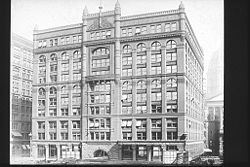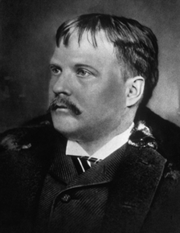
Burnham and Root
Encyclopedia

John Wellborn Root
John Wellborn Root was an American architect who worked out of Chicago with Daniel Burnham. He was one of the founders of the Chicago School style...
and Daniel Hudson Burnham
Daniel Burnham
Daniel Hudson Burnham, FAIA was an American architect and urban planner. He was the Director of Works for the World's Columbian Exposition in Chicago. He took a leading role in the creation of master plans for the development of a number of cities, including Chicago and downtown Washington DC...
established as one of Chicago
Chicago
Chicago is the largest city in the US state of Illinois. With nearly 2.7 million residents, it is the most populous city in the Midwestern United States and the third most populous in the US, after New York City and Los Angeles...
's most famous architectural companies of the nineteenth century.
During their eighteen years of partnership, Burnham and Root designed and built residential and commercial buildings. Their success was crowned with the coordination of the World's Columbian Exposition
World's Columbian Exposition
The World's Columbian Exposition was a World's Fair held in Chicago in 1893 to celebrate the 400th anniversary of Christopher Columbus's arrival in the New World in 1492. Chicago bested New York City; Washington, D.C.; and St...
(World's Fair) in 1893. The two men met when they worked as apprentice draftsmen in the offices of Drake, Carter, and Wright in 1872. A year later they established their own architecture office and began work by building private residences for the wealthy elite of Chicago
Chicago
Chicago is the largest city in the US state of Illinois. With nearly 2.7 million residents, it is the most populous city in the Midwestern United States and the third most populous in the US, after New York City and Los Angeles...
's meat industry. Both of them married into wealthy families which allowed them to establish a basis for their business. "Daniel Hudson Burnham was one of the handsomest men I ever saw," said Paul Starrett
Paul Starrett
Paul Starrett was an American builder. In 1883,he graduated from Lake Forest Academy,an elite boarding school for boys which was part of the Lake Forest, Illinois educational experiment. His brothers also graduated from this institution...
who joined Burnham and Root in 1888 (later he designed the Empire State Building
Empire State Building
The Empire State Building is a 102-story landmark skyscraper and American cultural icon in New York City at the intersection of Fifth Avenue and West 34th Street. It has a roof height of 1,250 feet , and with its antenna spire included, it stands a total of 1,454 ft high. Its name is derived...
). "It was easy to see how he got commissions. His very bearing and looks were half the battle". While Burnham was the pragmatic designer and impressive salesperson, Root became the creative genius of the company. When Burnham and Root were together, one woman said "I used always to think of some big strong tree with lightning playing around it". Louis Sullivan
Louis Sullivan
Louis Henri Sullivan was an American architect, and has been called the "father of skyscrapers" and "father of modernism" He is considered by many as the creator of the modern skyscraper, was an influential architect and critic of the Chicago School, was a mentor to Frank Lloyd Wright, and an...
, the famous architect, called Burnham "a colossal merchandiser" obsessed with building the biggest and costliest structures of the city.


Following his success and the loss of his business partner, Burnham continued to operate under the name D. H. Burnham and Co. The projects begun by Root were completed, including the Masonic Temple in 1892, which was for a short period the tallest building in the world at 22 stories. It is then that Burnham's architectural talent became the driving force of the business, resulting in such iconic buildings such as the Flatiron Building
Flatiron Building
The Flatiron Building, or Fuller Building, as it was originally called, is located at 175 Fifth Avenue in the borough of Manhattan, New York City and is considered to be a groundbreaking skyscraper. Upon completion in 1902 it was one of the tallest buildings in the city and the only skyscraper...
in New York City. Burnham was unable to maintain the architectural progress made by Root, but he demonstrated great versatility in his style. Burnham died in a car accident in 1912 while vacationing in Germany.
Selected Burnham and Root buildings
- Montezuma Castle (hotel)Montezuma Castle (Hotel)The Montezuma Castle is a , 400 room Queen Anne-style hotel building erected just northwest of the city of Las Vegas, New Mexico in 1886...
- Rookery BuildingRookery BuildingThe Rookery Building is a historic landmark located in the Loop community area of Chicago in Cook County, Illinois, United States. Completed by John Wellborn Root and Daniel Burnham of Burnham and Root in 1888, it is considered one of their masterpiece buildings. It once housed the office of the...
- Heyworth BuildingHeyworth BuildingThe Heyworth Building is a Chicago Landmark located at 29 East Madison Street, on the southwest corner of Madison Street and Wabash Avenue in Chicago, Illinois....
- Luzon BuildingLuzon BuildingThe Luzon Building was a historic six-story building in downtown Tacoma, Washington designed by Chicago architects Daniel Burnham and John Root. The Luzon was built in 1890 as the Pacific National Bank, which had a first floor entrance on Pacific Avenue and a second floor entrance on Commerce...
- Masonic Temple (Chicago, Illinois)
- Monadnock BuildingMonadnock BuildingThe Monadnock Building , is a skyscraper located at 53 West Jackson Boulevard in the south Loop community area of Chicago, Illinois. The north half of the building was designed by the firm of Burnham & Root and built in 1891...
- Rand McNally BuildingRand McNally BuildingThe Rand McNally Building , in Chicago, was designed by Burnham and Root and was the world's first all-steel framed skyscraper.The building was located at 160-174 Adams Street and also fronted #105-#119 on the backside . It was erected in 1889 at a cost of $1 million...
(1889, the first all-steel framed skyscraper) - Sydney Kent HouseSydney Kent HouseThe Kent House, also known as Sydney Kent House or St. James Convent, is a Queen Anne style house located at 2944 South Michigan Avenue in Chicago, Illinois, United States. The house was built in 1883 by Burnham & Root for Sidney A. Kent...
- Equitable Building (Atlanta 1892)Equitable Building (Atlanta 1892)The 1892 Equitable Building was a low rise building 30 Edgewood Avenue SE, Atlanta, Georgia. It was built for Joel Hurt, a prominent Atlanta developer and streetcar magnate...

